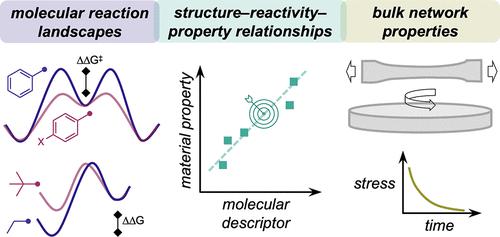当前位置:
X-MOL 学术
›
J. Am. Chem. Soc.
›
论文详情
Our official English website, www.x-mol.net, welcomes your
feedback! (Note: you will need to create a separate account there.)
Structure–Reactivity–Property Relationships in Covalent Adaptable Networks
Journal of the American Chemical Society ( IF 14.4 ) Pub Date : 2022-11-29 , DOI: 10.1021/jacs.2c08104 Vivian Zhang 1 , Boyeong Kang 1 , Joseph V Accardo 1 , Julia A Kalow 1
Journal of the American Chemical Society ( IF 14.4 ) Pub Date : 2022-11-29 , DOI: 10.1021/jacs.2c08104 Vivian Zhang 1 , Boyeong Kang 1 , Joseph V Accardo 1 , Julia A Kalow 1
Affiliation

|
Polymer networks built out of dynamic covalent bonds offer the potential to translate the control and tunability of chemical reactions to macroscopic physical properties. Under conditions at which these reactions occur, the topology of covalent adaptable networks (CANs) can rearrange, meaning that they can flow, self-heal, be remolded, and respond to stimuli. Materials with these properties are necessary to fields ranging from sustainability to tissue engineering; thus the conditions and time scale of network rearrangement must be compatible with the intended use. The mechanical properties of CANs are based on the thermodynamics and kinetics of their constituent bonds. Therefore, strategies are needed that connect the molecular and macroscopic worlds. In this Perspective, we analyze structure–reactivity–property relationships for several classes of CANs, illustrating both general design principles and the predictive potential of linear free energy relationships (LFERs) applied to CANs. We discuss opportunities in the field to develop quantitative structure–reactivity–property relationships and open challenges.
中文翻译:

共价适应性网络中的结构-反应性-性质关系
由动态共价键构建的聚合物网络提供了将化学反应的控制和可调性转化为宏观物理性质的潜力。在发生这些反应的条件下,共价适应性网络(CAN)的拓扑结构可以重新排列,这意味着它们可以流动、自我修复、重塑并对刺激做出反应。具有这些特性的材料对于从可持续发展到组织工程等领域都是必需的;因此,网络重组的条件和时间范围必须与预期用途相一致。 CAN 的机械性能基于其组成键的热力学和动力学。因此,需要连接分子世界和宏观世界的策略。在本视角中,我们分析了几类 CAN 的结构-反应性-性能关系,说明了一般设计原理和应用于 CAN 的线性自由能关系 (LFER) 的预测潜力。我们讨论了该领域发展定量结构-反应性-性质关系的机会和开放的挑战。
更新日期:2022-11-29
中文翻译:

共价适应性网络中的结构-反应性-性质关系
由动态共价键构建的聚合物网络提供了将化学反应的控制和可调性转化为宏观物理性质的潜力。在发生这些反应的条件下,共价适应性网络(CAN)的拓扑结构可以重新排列,这意味着它们可以流动、自我修复、重塑并对刺激做出反应。具有这些特性的材料对于从可持续发展到组织工程等领域都是必需的;因此,网络重组的条件和时间范围必须与预期用途相一致。 CAN 的机械性能基于其组成键的热力学和动力学。因此,需要连接分子世界和宏观世界的策略。在本视角中,我们分析了几类 CAN 的结构-反应性-性能关系,说明了一般设计原理和应用于 CAN 的线性自由能关系 (LFER) 的预测潜力。我们讨论了该领域发展定量结构-反应性-性质关系的机会和开放的挑战。











































 京公网安备 11010802027423号
京公网安备 11010802027423号